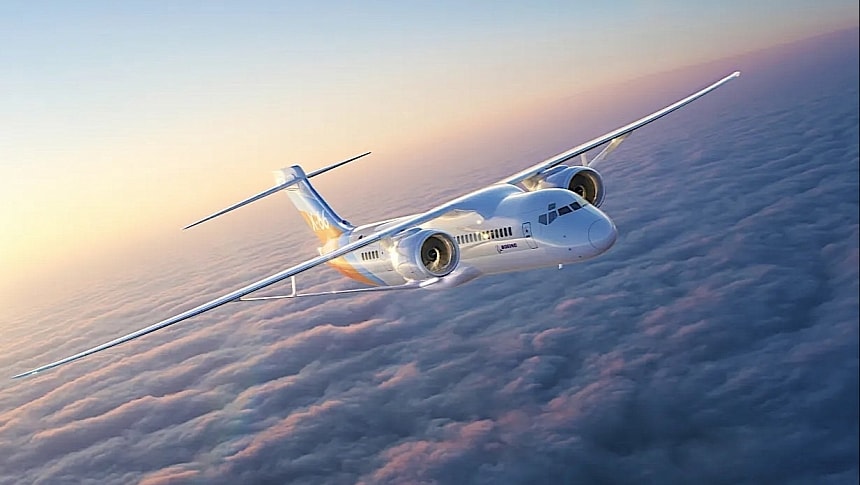Although its main area of expertise is outer space, the American agency NASA is knee-deep in aviation as well. Just as you’re reading this the organization is involved in projects meant to create new kinds of aircraft engines, it is working on advancing VTOL flight, and it has no less than two brand new aircraft in the works.
The first NASA aerial machine is the X-59. The result of an effort called Quiet Supersonic Technology (QueSST), this aircraft is meant to prove people and regulators that, given a certain design, planes could travel supersonic over land without fear of them disturbing the peace of American neighborhoods.
The second aircraft NASA is researching at the moment is the X-66A, part of the Sustainable Flight Demonstrator program. This one is meant to contribute to America's goal of achieving net-zero aviation emissions by 2050, something that could have huge implications in the fight against climate change.
Just like with the X-59, the main thing pushing the X-66A project forward is not necessarily some piece of innovative tech, but a rather radical change in design.
More precisely NASA and its partner in crime, Boeing, are betting on something called a Transonic Truss-Braced Wing (TTBW) to help bring down emissions. What TTBW means is essentially the addition of diagonal struts to connect the wings of the aircraft to its body, giving it a shape unlike any other.
This design would theoretically allow the plane to generate a lot more lift while at the same time burning less fuel to get the desired effect. Using the TTBW and other, yet unnamed technologies should allow the aircraft to cut down on its fuel consumption by as much as 30 percent compared to today's best-in-class aircraft.
A purpose-built machine for this task does not exist, but NASA and Boeing are hard at work converting an MD-90 single-aisle aircraft into the X-66A. The plane has already been delivered to Palmdale, California where it is being modified for the task.
There are also a number of computer-generated images of a yet non-existent X-66 going around, and NASA upped the ante a bid by releasing a fresh new one at the end of last week.
It shows the plane, for the first time, above the clouds, rocking pretty much the same shape we're used to from aviation, but with the truss-braced wings making it look truly special.
It will still be a very long time until we get to see the successors of the X-66A flying in the sky. The first test flights of the purpose-built demonstrator are not planned before 2028, even if the converted MD-90 will probably fly sooner.
Even if that goes without a hitch, the industry will have to adopt the TTBW and incorporate it into new aircraft designs, and that will likely take a lot more years too.
The second aircraft NASA is researching at the moment is the X-66A, part of the Sustainable Flight Demonstrator program. This one is meant to contribute to America's goal of achieving net-zero aviation emissions by 2050, something that could have huge implications in the fight against climate change.
Just like with the X-59, the main thing pushing the X-66A project forward is not necessarily some piece of innovative tech, but a rather radical change in design.
More precisely NASA and its partner in crime, Boeing, are betting on something called a Transonic Truss-Braced Wing (TTBW) to help bring down emissions. What TTBW means is essentially the addition of diagonal struts to connect the wings of the aircraft to its body, giving it a shape unlike any other.
This design would theoretically allow the plane to generate a lot more lift while at the same time burning less fuel to get the desired effect. Using the TTBW and other, yet unnamed technologies should allow the aircraft to cut down on its fuel consumption by as much as 30 percent compared to today's best-in-class aircraft.
A purpose-built machine for this task does not exist, but NASA and Boeing are hard at work converting an MD-90 single-aisle aircraft into the X-66A. The plane has already been delivered to Palmdale, California where it is being modified for the task.
There are also a number of computer-generated images of a yet non-existent X-66 going around, and NASA upped the ante a bid by releasing a fresh new one at the end of last week.
It shows the plane, for the first time, above the clouds, rocking pretty much the same shape we're used to from aviation, but with the truss-braced wings making it look truly special.
It will still be a very long time until we get to see the successors of the X-66A flying in the sky. The first test flights of the purpose-built demonstrator are not planned before 2028, even if the converted MD-90 will probably fly sooner.
Even if that goes without a hitch, the industry will have to adopt the TTBW and incorporate it into new aircraft designs, and that will likely take a lot more years too.










